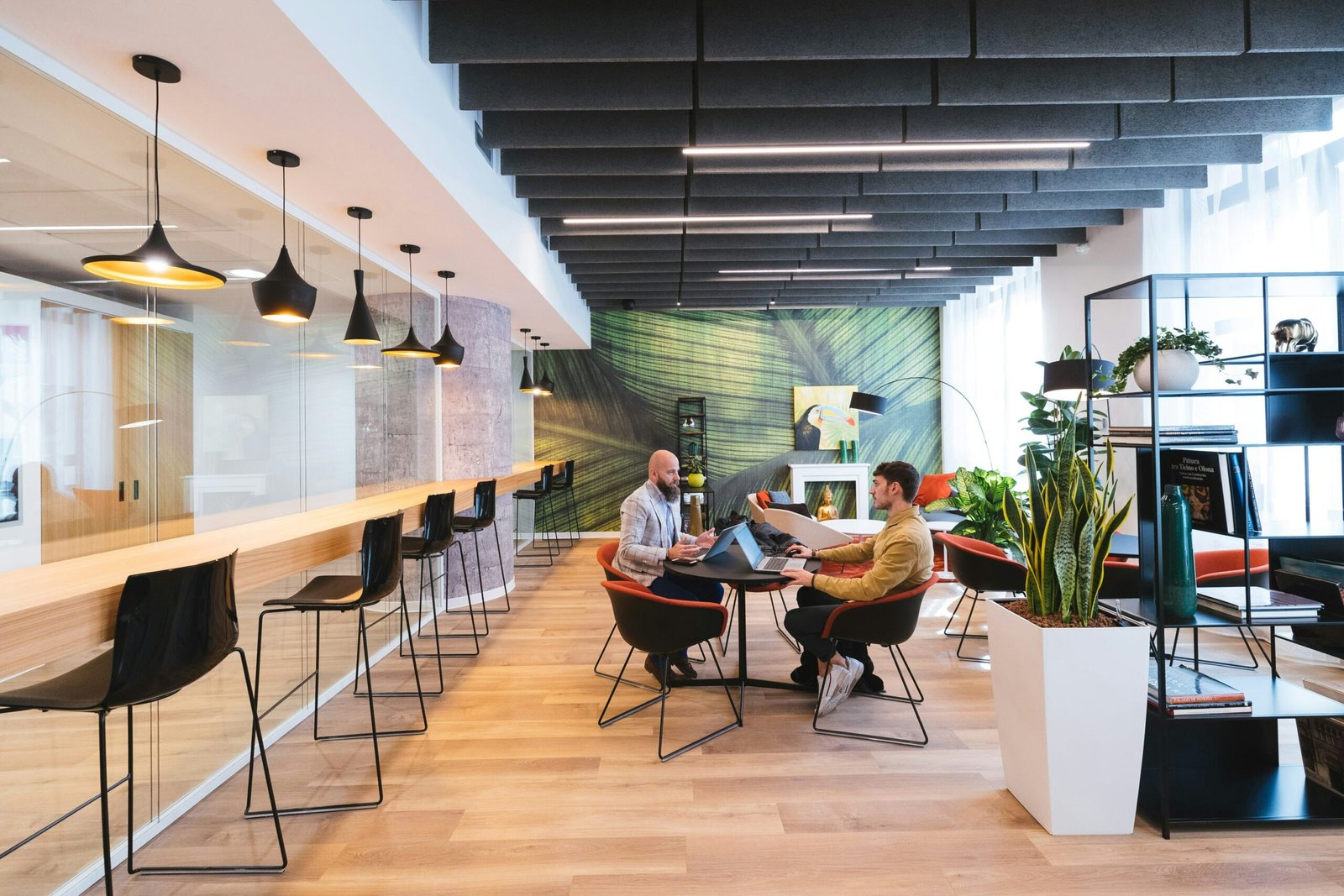In today’s fast-paced world, the line between virtual and physical workspaces is blurring. Now more than ever, creating an inviting and sustainable work environment is essential. Coworking spaces have emerged as a beacon for collaboration, creativity, and community. As the demand for these spaces grows, the focus on sustainable design becomes more important than ever. In this blog, we’ll delve into the importance of sustainable design in coworking spaces, why it matters for future growth, and how it can elevate your business.

Why Sustainable Design Matters
1. Environmental Responsibility
At the core of sustainable workspace solutions is the need to reduce our ecological footprint. Traditional building methods and materials harm the environment by using up resources and creating excess waste. Sustainable design in coworking spaces emphasizes using eco-friendly materials, promoting energy efficiency, and minimizing waste.
Implementing energy-efficient systems, such as LED lighting and smart climate control, not only reduces energy consumption but also lowers operating costs for the business and its members. Would you choose a workspace that aligns with your values? Today, more people are making eco-conscious decisions, even in their work life. By creating a sustainable coworking space, you’re not just reducing your environmental impact—you’re attracting professionals who care about the planet as much as you do.
2. Improved Health and Well-being
Did you know that poor office environments take a toll on employee well-being? Studies show that over 50% of employees experience burnout due to factors like lack of natural light and minimal greenery. This is why sustainable coworking spaces aren’t just an option—they’re essential. By incorporating natural light, indoor plants, and clean air, these spaces boost productivity, creativity, and overall well-being. Features like proper ventilation and non-toxic materials further create a healthier, more inspiring workplace.
Ever noticed how a walk in nature instantly lifts your mood? That’s the idea behind biophilic design—bringing nature indoors to create healthier, more inspiring workspaces. Studies show that workspaces with natural elements, like plants and sunlight, can increase productivity by up to 15%.
Imagine working in a space filled with greenery, natural textures, and large windows that let in fresh air and sunlight. Now compare that to a windowless office with fluorescent lights and stale air. Which one feels more energizing?
Sustainable coworking spaces use biophilic design to boost creativity, improve focus, and enhance overall well-being. It’s not just about aesthetics—it’s about creating an environment where people can truly thrive.
3. Competitive Advantage
As the coworking industry continues to grow, the market is becoming increasingly competitive. Truly innovative and eco-friendly coworking spaces can stand out from the crowded marketplace. By prioritizing sustainable design, you can position your space as a leader in the sector while attracting environmentally conscious clients.
One smart approach is to showcase your commitment to sustainability through certifications, such as the Leadership in Energy and Environmental Design (LEED) certification, awarded by the Green Building Council, is a globally recognized standard for sustainable building practices. It evaluates buildings based on energy efficiency, water conservation, indoor environmental quality, and overall sustainability, promoting eco-friendly and high-performance workspaces. This not only enhances your brand reputation but also appeals to businesses looking to enhance their sustainability practices as they seek sustainable workspace solutions.
4. Cost Effectiveness
Is sustainability in coworking spaces expensive? You might think so, but the reality is quite the opposite. In fact, eco-friendly practices often lead to long-term cost savings while creating a healthier, more productive workspace. Energy-efficient coworking spaces reduce utility costs, while investments in sustainable materials translate to lower maintenance costs over time.
Additionally, as renewable energy sources like solar become more popular, coworking spaces can harness these technologies to realize significant savings. Not to mention, the initial cost of sustainable design is steadily decreasing, making it more accessible for coworking businesses to invest in long-term savings.
5. Community Engagement
A well-designed sustainable coworking space fosters a sense of community and belonging among its members. Eco-friendly coworking spaces are increasingly being viewed as social hubs where like-minded professionals collaborate. According to a recent study, over 80% of coworking space users believe that sustainability enhances productivity and well-being, highlighting the growing impact of green workspaces.
Organizing workshops, networking events, or talks on sustainability not only enhances community spirit but establish your coworking space as a trailblazer in sustainability, drawing in forward-thinking members and clients who actively seek partnerships with businesses that champion their values. This powerful positioning not only enhances your brand but also fuels a thriving community committed to a greener future.
Key Features of Sustainable Coworking Spaces
1. Use of Renewable Materials
In designing your coworking space, consider utilizing renewable and recycled materials. Bamboo furniture, reclaimed wood, and recycled metal can create a beautiful aesthetic while reducing resource consumption.
2. Green Amenities
Incorporate energy-efficient appliances, LED lighting, and smart climate systems to reduce energy consumption. Providing bike racks, showers, and green transportation options can encourage environmentally friendly commuting.
3. Indoor Greenery
Integrating plants and greenery into your workspace not only improves air quality but also cultivates a tranquil atmosphere. Consider vertical gardens or indoor plants that thrive in low-light conditions.
4. Flexible Designs
Sustainable coworking spaces should also emphasize flexibility. Designs that allow for adaptable layouts make it easier to accommodate different teams and projects. Movable walls, modular furniture, and multipurpose areas can help maximize space while minimizing the use of materials.
5. Smart Technology
Embrace technology that facilitates energy efficiency—think smart lighting systems and energy-monitoring tools that can optimize usage based on occupancy.
Take Action: Transform Your Coworking Space into a Hub of Sustainability
At Broklink, we understand that sustainable design is about more than just appearance; it’s about creating an impactful environment that fosters connection and community. By ensuring your coworking space embraces sustainable practices, you’re not just making a wise business decision; you’re contributing positively to our planet’s future.
Are you ready to transform your workspace and join the movement towards sustainable coworking? Contact us today for a consultation on how to implement sustainable workspace solutions tailored to your needs. Let’s work together to create a space where everyone can Work, Connect, and Thrive.
Explore Now
As the demand for these spaces continues to rise, embracing sustainable practices is a key differentiator that can yield long-term benefits for businesses and their members. By prioritizing eco-friendliness, you enhance the workplace experience, improve health and productivity, and foster a community of like-minded professionals. Let’s make sustainability a priority in our shared workspaces and elevate the entire coworking experience.

